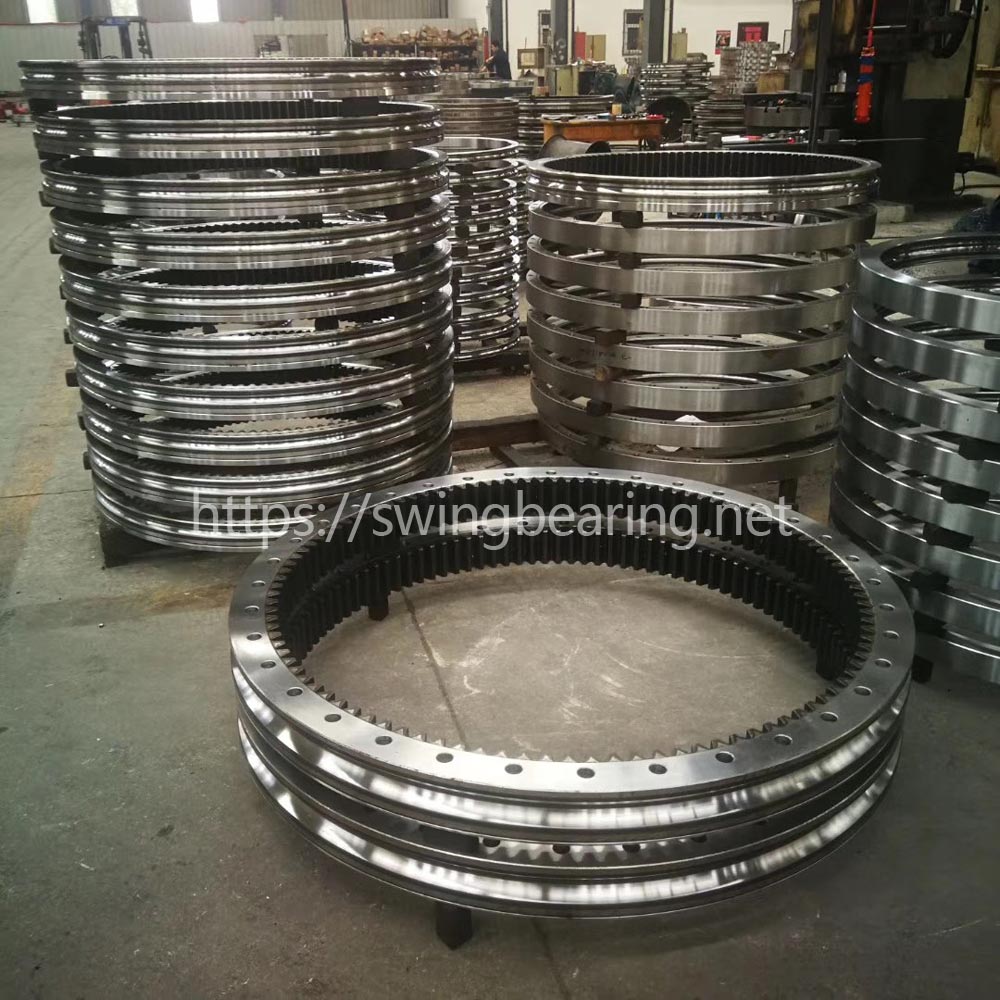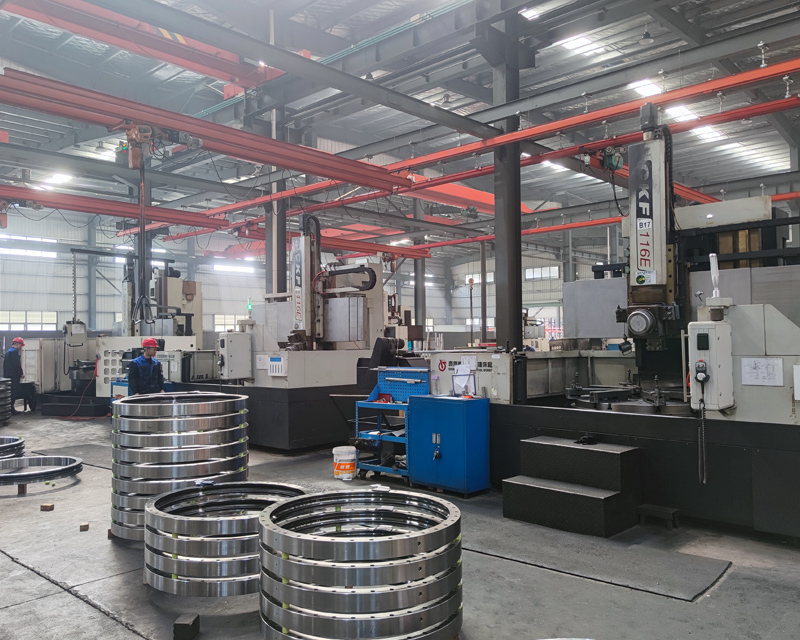
Swing bearings, also known as slewing bearings, are essential components in heavy machinery like the CAT 385C excavator. They facilitate the rotational movement of the upper structure relative to the undercarriage, allowing the excavator to swing its arm and bucket to perform various tasks. The proper functioning of the swing bearing is crucial for the smooth and efficient operation of the excavator. Any malfunction, including corrosion, can significantly impact the machine’s performance and lifespan.
The swing bearing with part number 199-4491 is specifically designed for the CAT 385C excavator. It is a robust and precision-engineered component that must withstand extreme loads and harsh operating conditions. Understanding its specifications and how it integrates with the rest of the machine is essential for effective maintenance and handling of issues like corrosion.
Corrosion on swing bearings can manifest in various ways. The most obvious signs include visible rust and discoloration on the bearing surface. Other symptoms might include unusual noises such as grinding or squeaking during operation, increased friction, and resistance when the bearing rotates, or even a complete seizure of the bearing mechanism.
Several factors can contribute to the corrosion of swing bearings. These include exposure to moisture, chemicals, and other environmental elements. Lack of proper lubrication and maintenance can also accelerate the corrosion process. Understanding these causes is vital for preventing corrosion and implementing effective treatment measures.

Routine inspection and maintenance are the first lines of defense against corrosion. Regularly check the bearing for signs of wear and tear, rust, and other forms of damage. Keeping a maintenance log can help track the condition of the bearing over time and identify patterns that might indicate an underlying issue.
Lubrication is crucial in preventing corrosion. Use high-quality lubricants that are compatible with the swing bearing’s materials and operating conditions. Regularly apply lubricants according to the manufacturer’s recommendations to create a protective barrier against moisture and contaminants.
Protect the excavator and its components from harsh environmental conditions. When not in use, store the machine in a sheltered area to minimize exposure to rain, snow, and other corrosive elements. If the excavator operates in a particularly harsh environment, consider using protective covers or coatings on the swing bearing.
If corrosion is detected, the first step is to clean the affected area. Use a wire brush or sandpaper to remove rust and debris from the bearing surface. Be thorough but gentle to avoid causing additional damage to the bearing.
After cleaning, apply a rust remover or converter to the affected area. These products chemically react with the rust, either dissolving it or converting it into a stable compound that prevents further corrosion. Follow the manufacturer’s instructions carefully for the best results.
Once the rust has been treated, reapply a generous amount of lubricant to the bearing. Ensure that the lubricant reaches all parts of the bearing, including the internal components. After lubrication, seal the bearing to protect it from future exposure to moisture and contaminants.
In some cases, corrosion might have caused significant damage to the swing bearing. Assess the extent of the damage to determine whether the bearing can be repaired or needs to be replaced. Minor surface rust can often be treated, but extensive pitting, cracks, or structural damage usually require a replacement.
For minor to moderate corrosion damage, repair techniques might include polishing the bearing surface, filling pits with epoxy or other suitable materials, and re-machining the bearing to restore its original dimensions and smoothness. These repairs should be carried out by qualified technicians to ensure the bearing’s integrity and performance.
If the damage is beyond repair, replacing the swing bearing is the best option. When replacing the bearing, follow the manufacturer’s guidelines and use genuine parts to ensure compatibility and reliability. Proper installation is crucial to prevent future issues, so consider enlisting professional assistance if necessary.
After treating or replacing a corroded swing bearing, implement a rigorous maintenance schedule to prevent recurrence. Regular inspections, lubrication, and environmental protection should be part of the ongoing maintenance plan.

Closely monitor the performance of the swing bearing after treatment or replacement. Pay attention to any changes in noise, vibration, or resistance during operation. Early detection of potential issues can prevent major failures and extend the bearing’s lifespan.
Corrosion on swing bearings, such as the 199-4491 for the CAT 385C excavator, can significantly impact the machine’s performance and longevity. Regular inspection, proper lubrication, and environmental protection are crucial in preventing corrosion. When corrosion occurs, cleaning, treating with rust removers, re-lubricating, and sealing the bearing are essential steps. Assessing the extent of damage helps determine whether the bearing can be repaired or needs to be replaced. Ongoing maintenance and performance monitoring are vital for ensuring the longevity of the treated or replaced bearing.
Handling corrosion on swing bearings requires a proactive approach, combining preventive measures with effective treatment and repair techniques. By understanding the causes, symptoms, and treatment methods for corrosion, operators and maintenance personnel can ensure the reliable operation of their excavators and extend the lifespan of critical components like the swing bearing. Regular maintenance, proper handling, and the use of high-quality materials are key to preventing and addressing corrosion issues, ensuring the excavator remains in optimal working condition.
The CAT 385C 199-4491 swing bearing plays a crucial role in the operation of the CAT 385C excavator. This component is designed to facilitate the rotational movement of the upper structure of the excavator relative to its undercarriage. This rotation allows the excavator to swing its arm and bucket smoothly and efficiently, which is essential for performing various digging, lifting, and loading tasks. The swing bearing must withstand significant loads, including axial force, radial force, and tipping moments, ensuring that the excavator can operate effectively in demanding conditions.
Common signs of wear or failure in the CAT 385C 199-4491 swing bearing include:
Preventing corrosion and extending the lifespan of the CAT 385C 199-4491 swing bearing involves several proactive measures:
By following these preventive measures, operators can significantly reduce the risk of corrosion and extend the operational life of the CAT 385C 199-4491 swing bearing, ensuring reliable performance and reducing the need for costly repairs or replacements.